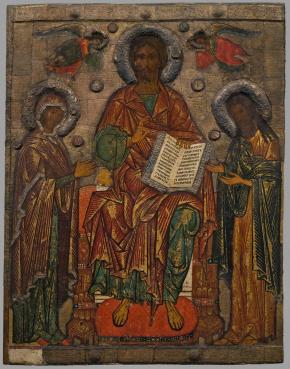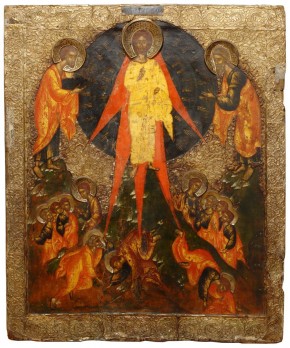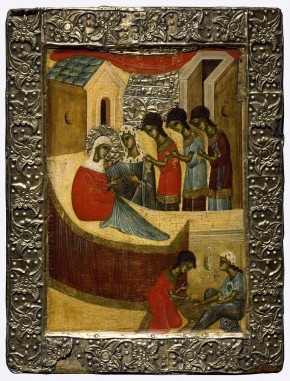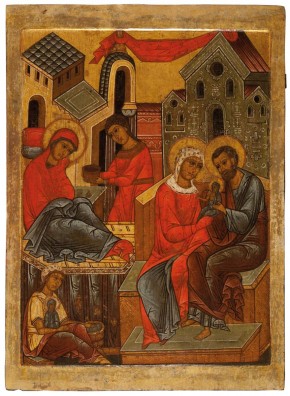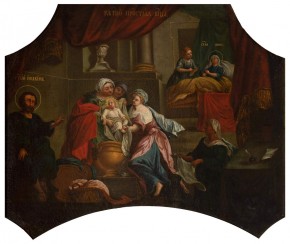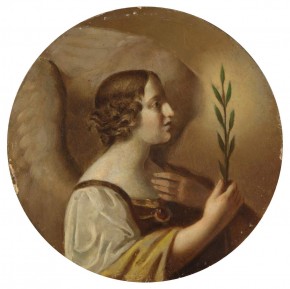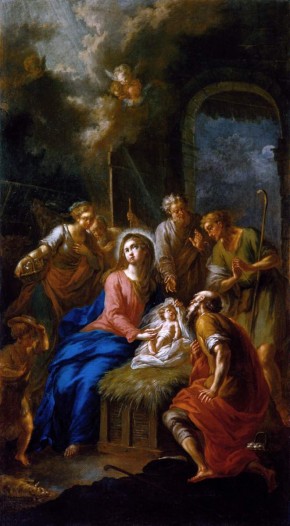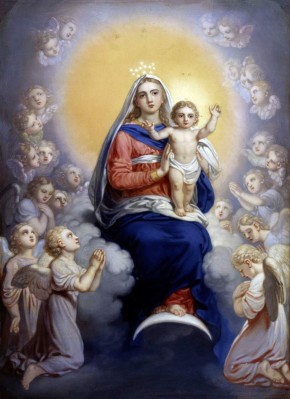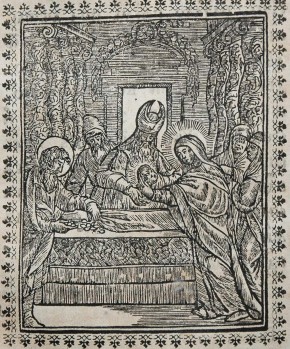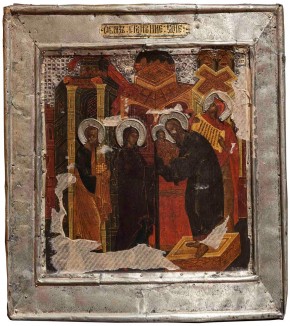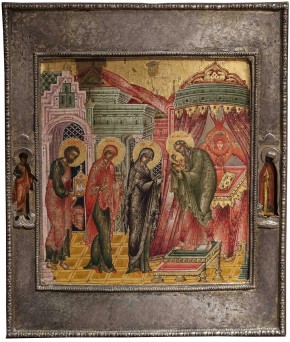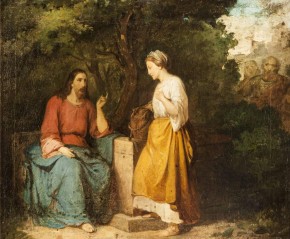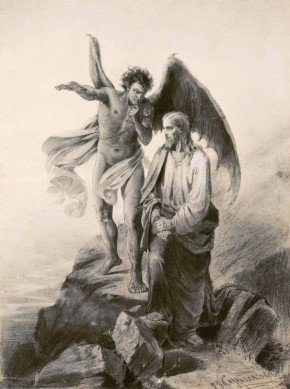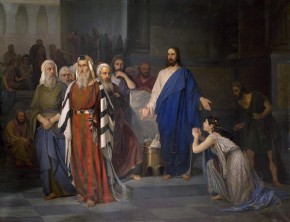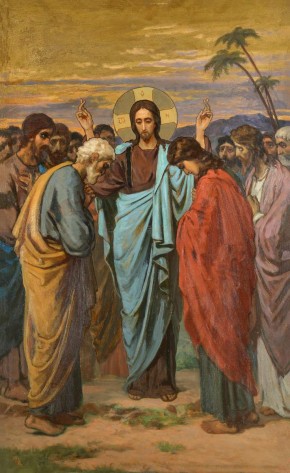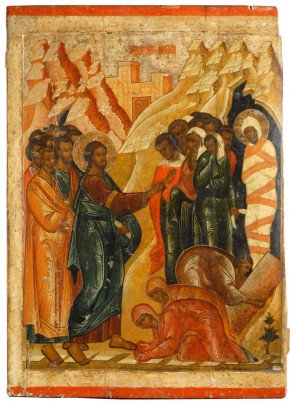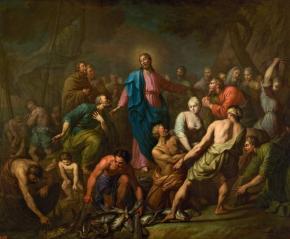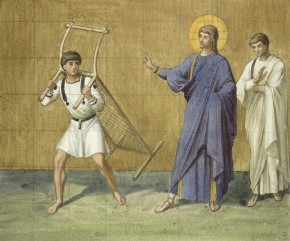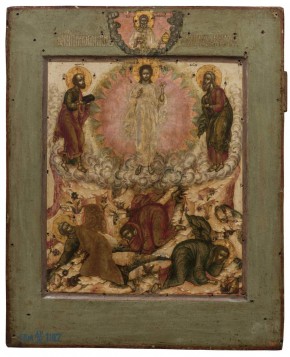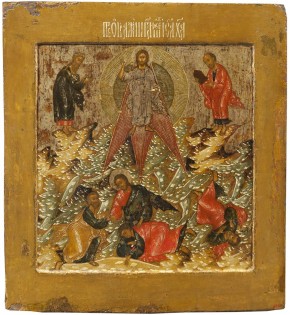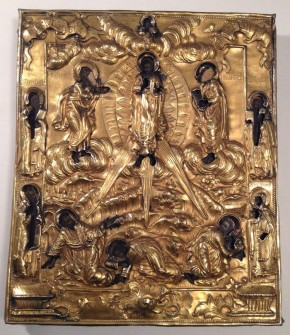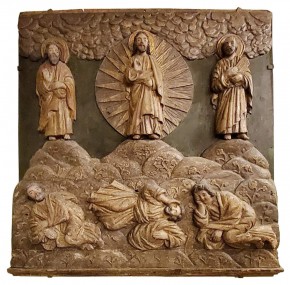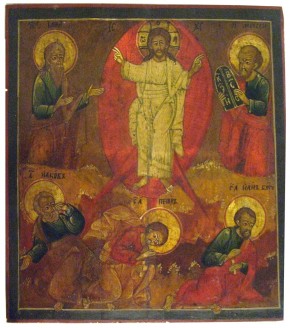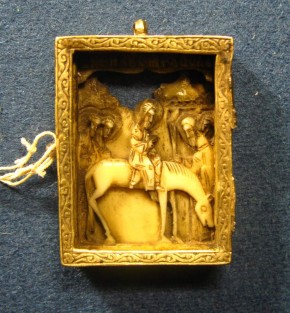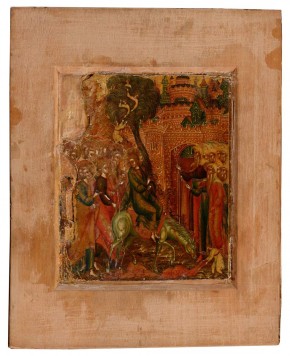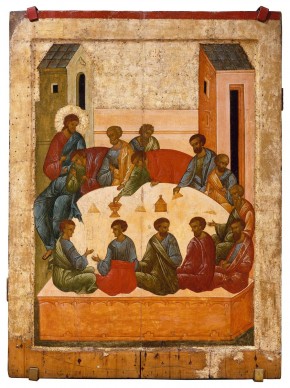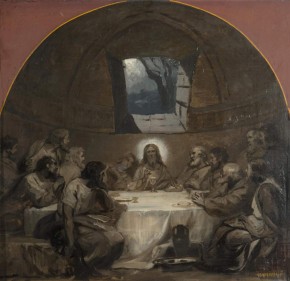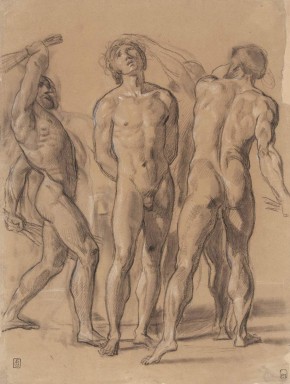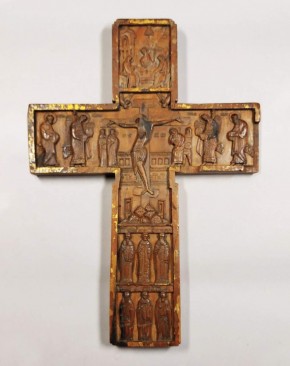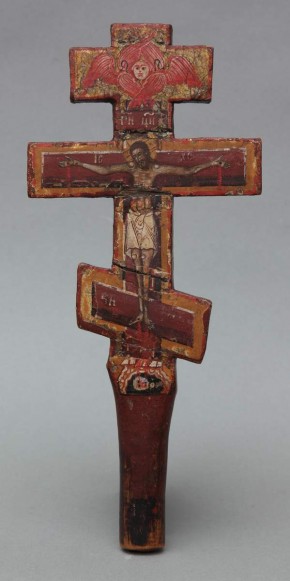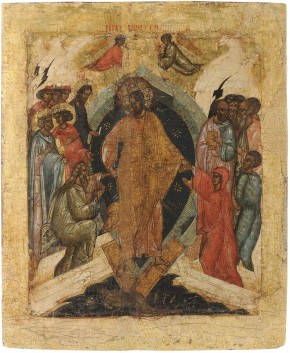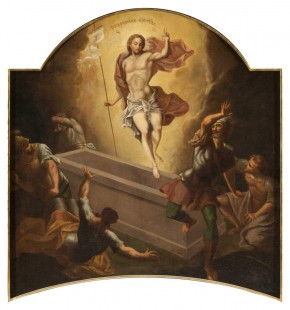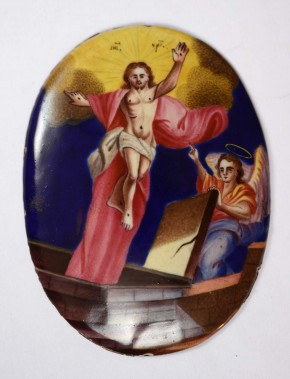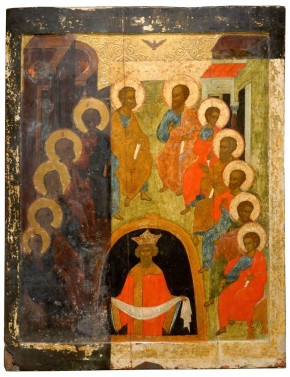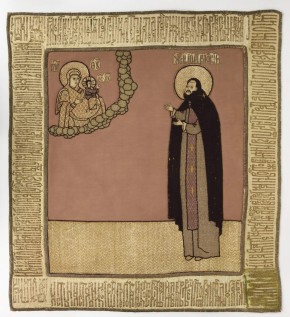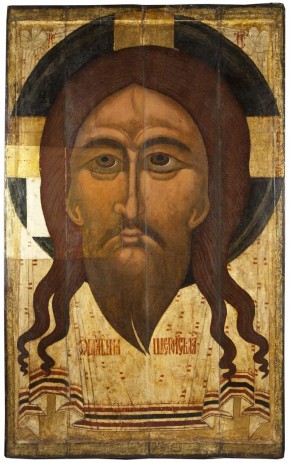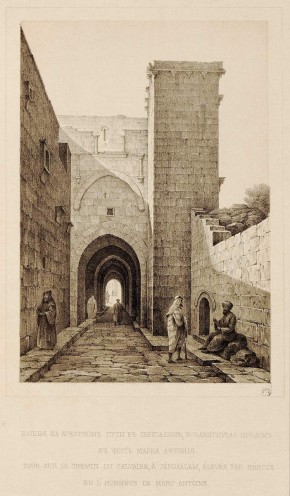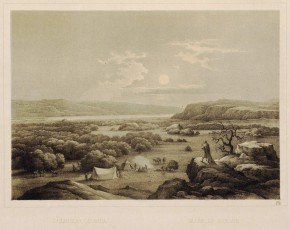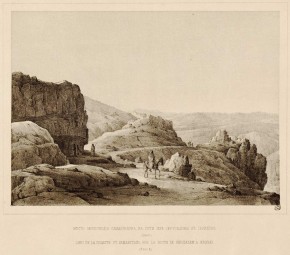Advanced search collections
Образок «Успение - Димитрий»
- Carving. 5,7 х 5 х 0,9
- The State Russian Museum
- ДРКам-45
Deesis
- Wood, pavoloka, gesso, tempera, metal.
- The State Russian Museum
- ДРЖ-2779
Миниатюра «Поклонение волхвов»
- 1340
- Tempera. 30,6 х 22,2
- The State Russian Museum
- Др.гр.-8
Христос Вседержитель
- Wood, gesso, tempera, . 33,5 × 23,3 × 1,5
- The State Russian Museum
- ДРЖ-1629
Воскресение (Сошествие во ад)
- Wood, tempera. 82,0 х 61,0 х 3,0
- The State Russian Museum
- ДРЖ-2124
Образка энколпия створка. Вход в Иерусалим
- Copper, casting. 6,4 х 5 х 0,5
- The State Russian Museum
- ДРМ-293
Преображение и Богоматерь Одигитрия
- Wood, gesso, silver, , , tempera, chasing, .
- The State Russian Museum
- ДРЖ-2728
Распятие
- Wood, gesso, tempera. 38,0 х 30,1 х 1,4
- The State Russian Museum
- ДРЖ-1084
Сошествие во Ад
- Wood, gesso, tempera.
- The State Russian Museum
- ДРЖ-2664
The Raising of Lazarus
- Late 14th - Early 15th century
- Wood, gesso, tempera. 53,5 х 44 х 4,5
- The State Russian Museum
- ДРЖ-1407
The Resurrection and Descent into Limbo
- Pskov
- Late 14th century
- Wood, tempera. 81,3 x 65 x 3
- The State Russian Museum
- ДРЖ-2120
The iconography of the scene is based on the apocryphal Gospel of St Nicodemus, liturgical texts, psalms, Old Testament prophecies, St Peter’s Epistles and patristic compositions. St Epiphanius of Constantia and St Eusebius of Alexandria’s Descent of Jesus Christ into Hell tell how Christ descended into the abyss after the Resurrection. He overthrew Satan and liberated the righteous, erasing the original sin of Adam and Eve with His blood.
The main idea of the Resurrection (Greek: Anastasis) is the celebration of Christ’s victory over hell and death. This concept is united in the icon with the theme of suffering and sorrow and trepidation before the inscrutable mystery of the Resurrection. The Resurrection of Christ was a particularly popular theme in the Pskov school of icon-painting, which developed its own unique version of the subject, quite unlike Byzantine or Old Russian iconography. Russian Museum: From Icons to the Modern Times. Palace Editions, St Petersburg, 2015. P. 44.
Богоматерь Одигитрия
- Wood, tempera. 32,4 х 26,7 х 2,6
- The State Russian Museum
- ДРЖ-2059
Успение Богоматери
- Wood, tempera. 59 × 46,5 × 4,5
- The State Russian Museum
- ДРЖ-1561
Плащаница «Христос во гробе»
- Taffeta, silk, . 68,5 х 114,5
- The State Russian Museum
- ДРТ-195
Спас Вседержитель («Ярое око») / Спас оплечный
- Wood, pavoloka, tempera, gesso.
- The State Russian Museum
- ДРЖ-1889
Успение Богоматери
- Wood, gesso, tempera. 58,8 х 45,4 х 2,5
- The State Russian Museum
- ДРЖ-2066
Крещение
- Wood, gesso, tempera. 124 x 93
- The State Russian Museum
- ДРЖ-2098
Сретение
- Wood, gesso, tempera.
- The State Russian Museum
- ДРЖ-2135
The Raising of Lazarus, The Old Testament Trinity, The Purification, STs. John the Theologian and Prochorus. Four-parts icon
- Novgorod
- About 1497
- Wood, gesso, tempera.
- The State Russian Museum
- ДРЖ-2775
This icon comes from the Church of St. George in Novgorod. The composition unites four scenes linked to one another. “The Raising of Lazarus” is one of Christ miracles described in the New Testament. “Trinity” is the symbol of spiritual unity in the form of three angels. “The Purification” depicts the scene of the presentation of Christ when he was an infant in a church. St. John the Theologian is represented dictating his revelation to Prochorus. All the features of this icon are characteristic of the Novogorod iconography during the 15th century, when it reached its pinnacle: the sense of proportion, the structured composition and the harmony of colours.
Воскрешение Лазаря
- Wood, pavoloka, gesso, tempera. 47,5 х 38,8 х 2,5
- The State Russian Museum
- ДРЖ-3069
Rublev Andrei
Circa 1370 - Circa 1425Leading Old Russian artist. Little authentic information on his biography exists. Lay brother of the St Sergius Monastery of the Trinity and then the Andronikov Monastery of the Saviour in Moscow. Helped Theophanes the Greek to paint the Cathedral of the Annunciation in the Moscow Kremlin (1405). Worked in Vladimir (1408). The famous Old Testament Trinity icon of the St Sergius Monastery of the Trinity is attributed to Rublev. Canonized by the Russian Orthodox Church (1988). Feast day 4/17 July.
Рождество Богоматери
- Wood, gesso, silver, tempera. 32 х 24 х 1,5
- The State Russian Museum
- ДРЖ-2131
Рождество Богоматери
- Wood, gesso, tempera, , , . 96,5 х 77 х 3
- The State Russian Museum
- ДРЖ-2070
Рождество Богоматери
- Wood, gesso, tempera. 61 х 52,7 х 2,3
- The State Russian Museum
- ДРЖ-1208
Рождество Богоматери, из праздничного чина
- Wood, pavoloka, gesso, tempera.
- The State Russian Museum
- ДРЖ-3173
Пелена. Рождество Богоматери
- Silk, , , , , .
- The State Russian Museum
- ДРТ-275
Рождество Богоматери
- Wood, tempera, , , , .
- The State Russian Museum
- ДРЖ-2316
Рождество Божией Матери
- 1755
- Canvas, oil. 56,5 х 77,5
- The State Russian Museum
- ЖБ-868
Рождество Богородицы
- 1823-1825
- Canvas, oil.
- The State Russian Museum
- Ж-11991
Рождество Богоматери. Рождество Христово. Рождество Иоанна Предтечи. Рождество Николая Чудотворца
- Wood, gesso, tempera. 25,2 х 21,1 х 2
- The State Russian Museum
- ДРЖ Б-659
Икона двусторонняя «Рождество Богоматери. Чудо Архангела Михаила о Флоре и Лавре»
- Wood, pavoloka, gesso, tempera. 74,0 х 65,0 х 3,5
- The State Russian Museum
- ДРЖ Б-994
Vishnyakov Ivan Yakovlevich
1699, Moscow - 1761, St PetersburgPainter, portraitist. Son of a mining master, who sent him to St Petersburg (1714). Apprentice of the Ministry of Construction (1727), painting master (1739), ensign (1742), captain (1742), collegiate assessor (1743), court councillor (i752).Headeda team of painters from the Ministry of Construction, decorated the Grand Palace in Peterhof, Summer Palace and Winter Palace in St Petersburg and palaces in Moscow and Kiev (from 1739). Painted icons for churches in St Petersburg. Restored icons and oil paintings.
Vighi, Antonio
Благовещение и Успение Богоматери
- Wood, pavoloka, gesso, fabric, tempera. 32,0 х 13,2 х 1,4
- The State Russian Museum
- ДРЖ-150
Благовещение
- Wood, pavoloka, gesso, tempera.
- The State Russian Museum
- ДРЖ-2891
Благовещение
- 1755–1756
- Canvas, oil. 31,5 х 69
- The State Russian Museum
- ЖБ-870
Благовещение
- Canvas, oil.
- The State Russian Museum
- ЖБ-713
Архангел Гавриил (из «Благовещения»)
- 1804–1809
- Oil.
- The State Russian Museum
- Ж-3178
Дева Мария (из «Благовещения»)
- 1804–1809
- Oil.
- The State Russian Museum
- Ж-3177
Благовещение
- Cardboard, oil. 35,5 х 28,5
- The State Russian Museum
- Ж-3174
Благовещение (Дева Мария и Архангел Гавриил)
- 1824–1825
- Wood, oil.
- The State Russian Museum
- Ж-3185-3186
Свидание девы Марии с Елизаветой
- 1823-1825
- Canvas, oil.
- The State Russian Museum
- Ж-11992
Архангел Гавриил (из «Благовещения»)
- 1830s
- Cardboard, oil.
- The State Russian Museum
- Ж-3327
Богоматерь (из «Благовещения»)
- 1830s
- Cardboard, oil.
- The State Russian Museum
- Ж-3326
Благовещение: Архангел Гавриил
- Paper, gouache, watercolours, graphite pencil.
- The State Russian Museum
- Р-40910
Благовещение: Дева Мария
- Paper, gouache, watercolours, graphite pencil.
- The State Russian Museum
- Р-40911
Благовещение: Архангел Гавриил
- 1899-1900
- Paper, gouache, watercolours, bronze, graphite pencil.
- The State Russian Museum
- Р-40886
Благовещение: Дева Мария
- 1899-1900
- Paper, gouache, graphite pencil.
- The State Russian Museum
- Р-40887
Благовещение
- 1916
- Canvas, tempera. 143 х 201,5
- The State Russian Museum
- Ж-8847
Belsky Ivan Ivanovich
Borovikovsky Vladimir Lukich
1757, Mirgorod - 1825, St PetersburgPainter, draughtsman, miniaturist, icon painter, portraitist. Born into a family of low rank Cossacks. Studied painting under his father, the icon painter Luke Borovik, in Mirgorod. Listed "above the specified number" in the Mirgorod regiment where his father and relatives served (1774). Awarded the rank of "comrade of the colours" (1783), resigned with the rank of lieutenant. Moved to St Petersburg (1788) and studied under Dmitry Levitsky and Johann Baptiste I Lampi. Nominated to the Imperial Academy of Arts (1794), academician of portrait painting (1795). Councillor of the Imperial Academy of Arts (1802). Contributed to the iconostasis of the Kazan Cathedralin St Petersburg (1804). Mason and member of Ekaterina Tatarinova\'\'s mystical sect.
Yegorov Alexei Yegorovich
1776, ? — 1851, St PetersburgPainter, draughtsman, engraver, iconographer. Author of pictures on historical themes and portraits. At the age of five was found in the Kalmyk steppe by Cossacks, and put into the Moscow foster home. Studied at the Imperial Academy of Arts (1782–1797). Awarded the title of artist and an Academy bursary (1797), taught drawing (1798). Fellow of the Imperial Academy of Arts in Italy (1803–1807). Appointed to the Imperial Academy of Arts (1800), academician (1807). Taught at the Imperial Academy of Arts from 1798, junior professor (1807), professor (1812), professor emeritus (1832). Expelled from the Academy at the express wish of Tsar Nicholas I (1840). Married Vera Martos, daughter of sculptor Ivan Martos.
Nesterov Mikhail Vasilyevich
1862, Ufa - 1942, MoscowPainter, portraitist, landscape artist, genre painter, author of memoirs and essays on artists. Studied at the Moscow School of Painting, Sculpture and Architecture (1877-81, 1884-86) and the Imperial Academy of Arts (1881-84). Full member of the Imperial Academy of Arts (1910). Member of the Society of Travelling Art Exhibitions (1896) and founding member of the Union of Russian Artists (1903). Contributed to the exhibitions of the Society of Travelling Art Exhibitions (1889-1901), World of Art (1899-1901), 36 Artists (1901-03), Union of Russian Artists (1922, 1923), All-Russian Exhibition in Nizhny Novgorod (1896), Exposition Universelle in Paris (1900), International Exhibitions in Munich (1898,1909) and Rome (1911), Die erste russische Kunstausstellung in Berlin (1922) and the Exhibition of Russian Art in New York (1924). Honoured Artist of the RUSSIAN SOVIET FEDERATED SOCIALIST REPUBLIC (1942).
Воинов Святослав Владимирович
Миниатюра «Поклонение волхвов»
- 1340
- Tempera. 30,6 х 22,2
- The State Russian Museum
- Др.гр.-8
Резная икона «Богоматерь на троне и Кирилл Белозерский»
- Wood, carving, , silver, chasing, engraving.
- The State Russian Museum
- БК-3467/а,б
Рождество Христово
- Wood, tempera. 48,8 х 40,8
- The State Russian Museum
- ДРЖ-1416
Рождество Христово
- Wood, gesso, tempera.
- The State Russian Museum
- ДРЖ-1248
Рождество Христово
- Wood, tempera. 94,7 х 76,4 х 3
- The State Russian Museum
- ДРЖ-3170
Рождество Христово
- Wood, gesso, tempera. 179,8 х 155 х 4,5
- The State Russian Museum
- ДРЖ-2923
Рождество Христово
- Wood, tempera. 35,8 х 30 х 2,2
- The State Russian Museum
- ДРЖ-2757
Рождество Христово
- Wood, tempera, , , , .
- The State Russian Museum
- ДРЖ Б-40
Рождество Христово
- Wood, gesso, tempera. 31,5 х 25,8 х 2,3
- The State Russian Museum
- ДРЖ-1146
Собор Богородицы
- 1680–1690s
- Wood, , , pavoloka, tempera. 179 × 137 × 4
- The State Russian Museum
- ДРЖ-2890
Рождество Христово
- Wood, , , , gesso, tempera.
- The State Russian Museum
- ДРЖ-1962
Рождество Христово
- Wood, tempera.
- The State Russian Museum
- ДРЖ-2764
Образок-сердечко «Поклонение волхвов»
- Copper, , . 5 х 4 х 0,3
- The State Russian Museum
- ОНИ/Р-670
Рождество Христово
- Canvas, oil. 109 х 60
- The State Russian Museum
- ЖБ-2014
Рождество Христово
- Wood, tempera. 100 х 125 х 3,5
- The State Russian Museum
- ДРЖ Б-541
Богоматерь с Младенцем
- 1806–1809
- Oil. 168 х 85
- The State Russian Museum
- ЖБ-901
Богоматерь с Младенцем в сонме ангелов
- Wood, oil. 33,5 х 25
- The State Russian Museum
- Ж-3183
Богоматерь с Младенцем
- 1823
- Wood, oil. 35,5 х 25,5
- The State Russian Museum
- Ж-3176
Богоматерь с Младенцем в сонме ангелов
- 1823
- Wood, oil. 35 х 25,5
- The State Russian Museum
- ЖБ-400
Богоматерь в окружении ангелов
- 1824–1825
- Oil, wood. 227 х 70
- The State Russian Museum
- Ж-3192
Мастер Михаил
Строгановская школа
Markov Ivan
Kiprensky Orest Adamovich
1772, Nezhinskaya (St Petersburg Province) - 1836, RomePortraitist, history painter, draughtsman.
Illegitimate son of a serf woman, Anna Gavrilova, who gave him the name Kipreisky, later changed to Kiprensky. Grew up in the family of his foster father Adam Schwalde. Emancipated from serfdom and enrolled in the Imperial Academy of Arts (1788). Studied history painting under Grigory Ugryumov and Gabriele-Francois Doyen. Fellow of the Imperial Academy of Arts (1803-09). Worked in St Petersburg, Moscow and Tver. Academician of portrait painting (1812), councillor of the Imperial Academy of Arts (1815). Contributed to the exhibitions of the Imperial Academy of Arts. Lived in Italy (1816-23, 1828-36). Contributed to the Paris Salon (1822). Donated Self-Portrait (1820) to the Galleria degli Uffizi in Florence (1825). Appointed second-class professor of history and portrait painting with automatic member¬ship of the nobility (1831). Councillor of the Accademia di Belle Arti in Naples (1831). Buried at Sant\'\' Andrea delle Fratte in Rome.
Сретение
- Wood, gesso, tempera.
- The State Russian Museum
- ДРЖ-2135
The Raising of Lazarus, The Old Testament Trinity, The Purification, STs. John the Theologian and Prochorus. Four-parts icon
- Novgorod
- About 1497
- Wood, gesso, tempera.
- The State Russian Museum
- ДРЖ-2775
This icon comes from the Church of St. George in Novgorod. The composition unites four scenes linked to one another. “The Raising of Lazarus” is one of Christ miracles described in the New Testament. “Trinity” is the symbol of spiritual unity in the form of three angels. “The Purification” depicts the scene of the presentation of Christ when he was an infant in a church. St. John the Theologian is represented dictating his revelation to Prochorus. All the features of this icon are characteristic of the Novogorod iconography during the 15th century, when it reached its pinnacle: the sense of proportion, the structured composition and the harmony of colours.
Сретение
- Wood, gesso, tempera. 103 x 81 x 3
- The State Russian Museum
- ДРЖ-2132
Образок. Сретение
- Silver, carving. 4 х 3,8 х 0,5
- The State Russian Museum
- ДРКам-44
Сретение, из праздничного чина
- Wood, gesso, tempera. 94,6 х 76,6 х 2,6
- The State Russian Museum
- ДРЖ-3164
Введение во храм. Рождество Христово
- Canvas, gesso, tempera. 31,4 х 26,5 х 1,4
- The State Russian Museum
- ДРЖ-375
Богоматерь с Младенцем и Иосиф
- Tempera, mixed media.
- The State Russian Museum
- ДРЖ-2653, ДРЖ-2655
Сретение
- Wood, gesso, tempera. 31,2 х 26,3 х 2,3
- The State Russian Museum
- ДРЖ-1151
Сретение
- Wood, gesso, silver, tempera. 34,0 х 28,0 х 2,4
- The State Russian Museum
- ДРЖ-3161
Сретение
- 1750
- Paper, .
- The State Russian Museum
- Гр.-42922
Сретение Господне
- Canvas, oil. 36,5 х 58,5
- The State Russian Museum
- ЖБ-823
Сретение
- 1755–1756
- Canvas, oil. 56,5 х 77,5
- The State Russian Museum
- ЖБ-864
Сретение
- Wood, gesso, silver, tempera, chasing, engraving, . 32,1 х 27,5 х 2,8
- The State Russian Museum
- ДРЖ Б-896
Сретение Господне
- Oil. 50,5 х 108
- The State Russian Museum
- Ж-5470
Сретение и Крещение
- 1815
- Tempera. 45 х 74 х 3,5
- The State Russian Museum
- ДРЖ Б-1290
Святое семейство. Богоматерь с младенцем
- 1823 - 1825
- Canvas, oil.
- The State Russian Museum
- Ж-11990
Сретение
- Wood, gesso, silver, tempera, engraving, . 30,8 х 27,5 х 3,0
- The State Russian Museum
- ДРЖ Б-567
Сретение с Ангелом-хранителем и Иоасафом
- Wood, gesso, silver, tempera, chasing, engraving. 32,7 х 27,5 х 3,8
- The State Russian Museum
- ДРЖ Б-966
Святое семейство
- 1858
- Canvas, oil. 61 х 43
- The State Russian Museum
- Ж-3492
Святое семейство
- 1858
- Canvas, oil. 101 х 95
- The State Russian Museum
- Ж-3546
Unknown engraver
Михайлов Д.
Ivanov Andrei Ivanovich
1775, Moscow – 1848, St PetersburgHistory painter, portraitist, draughtsman, iconpainter, lithographer, teacher. Studied at the Moscow Foundling Hospital (from 1778) and the Imperial Academy of Arts (from 1782). Awarded silver medals (1794, 1795) and first gold medal for Noah Offering a Sacrifice to God After Leaving the Ark (1797). Awarded first-class degree, fellowship and post of teacher of drawing at the Imperial Academy of Arts (1797). Nominated to the Imperial Academy of Arts (1800), academician of history painting for Adam and Eve Under a Tree After the Banishment from Paradise (1803). Assistant professor (1806), professor (1812), senior professor (1821). Member of the Free Society of Lovers of Writing, Science and Arts (1802).
Reutern, Gerhardt von (Evgraf Romanovich)
1794, Gute Rosthof, Livonia Gubernia — 1865, Frankfurt-am-MainPainter, portraitist, genre artist, landscapist, author of history paintings. Studied at the St. Peter School in St. Petersburg. Joined a Hussar regiment (1811), fought in the war against Napoleon. Lost his right arm in the Battle of Leipzig (1813). Left the Russian Army to dedicate himself to painting (1819), worked with his left hand. Travelled across Italy and Germany, lived in Switzerland and studied in Düsseldorf. Nominated to the Imperial Academy of Arts (1835), later — academician. Painter to the Imperial family with the right to live abroad (1837). Settled in Frankfurt-am-Main (1844).
Шамшин Петр Михайлович
Крещение
- Wood, gesso, tempera. 124 x 93
- The State Russian Museum
- ДРЖ-2098
Крещение, из праздничного чина
- Wood, pavoloka, gesso, tempera. 103,0 х 81,5 х 2,5
- The State Russian Museum
- ДРЖ-1891
Крещение, из праздничного чина
- Wood, gesso, tempera. 95,0 х 76,2 х 3,0
- The State Russian Museum
- ДРЖ-3172
Пелена «Крещение Господне»
- 1580–1590s
- Pearls. 49 х 40
- The State Russian Museum
- ДРТ-37
Крещение (Богоявление)
- Wood, tempera. 35,6 х 30 х 2,4
- The State Russian Museum
- ДРЖ-1020
Воздух. Крещение
- Canvas, silk, , , , . 29,5 х 27,5
- The State Russian Museum
- ДРТ-116
Крещение
- 1650s
- Wood, , , , pavoloka, gesso, tempera, , silver, carving, engraving, , gilding. 40,4 × 31,2 × 3,5
- The State Russian Museum
- ДРЖ-266
Крещение
- Wood, gesso, tempera. 31,5 х 27,0 х 2,1
- The State Russian Museum
- ДРЖ-2251
Крещение
- Wood, gesso, tempera.
- The State Russian Museum
- ДРЖ-1198
Крещение
- Wood, tempera.
- The State Russian Museum
- ДРЖ-1512
Образок-сердечко «Крещение Христа. Бичевание Христа»
- Copper, , . 3,8 х 3,5 х 0,5
- The State Russian Museum
- ОНИ/Р-357
Крещение Господне
- 1808
- Canvas, oil. 204 х 138
- The State Russian Museum
- Ж-3332
Крещение Спасителя
- 1810–1811
- Oil. 50,5 х 109
- The State Russian Museum
- Ж-5471
Сретение и Крещение
- 1815
- Tempera. 45 х 74 х 3,5
- The State Russian Museum
- ДРЖ Б-1290
Явление Христа народу
- 1834
- Canvas, oil. 60,5 х 90,5
- The State Russian Museum
- Ж-5266
Christ’s Appearance to the People
- Begun in 1836 and completed after 1855
- Canvas, oil. 172 x 247
- The State Russian Museum
- Ж-5268
This work is a small version of Alexander Ivanov’s famous painting of the same name now in the Tretyakov Gallery. The study allowed the artist to experiment with a series of ideas and resolutions, before embarking on the final picture. There are, in fact, only minor differences between this work and the final version. Ivanov originally planned to paint a picture the same size as this study, though gradually arrived at more monumental forms in the course of work on the canvas.
This study illustrates the grandiose concept of Christ’s Appearance to the People and the artist’s attempt to convey the general meaning of the Gospels, employing a subject that unites prophecy and fulfillment and symbolises the birth of a new world. Russian Museum: From Icons to the Modern Times. Palace Editions, St Petersburg, 2015. P. 145.
Богоявление
- 1839
- Paper, . 36,2 х 24,3
- The State Russian Museum
- Гр.Луб.-2158
Голова Иоанна Крестителя
- 1840s
- Paper, oil. 64,2 х 58
- The State Russian Museum
- Ж-5284
Голова Иоанна Богослова
- 1840–1850s
- Graphite pencil. 30,1 х 44,5
- The State Russian Museum
- Р-13208
Крещение Христа
- Watercolours, white pigment, graphite pencil. 33,2 x 24,2
- The State Russian Museum
- Р-26239
ARMOURY CHAMBER, Moscow
Волков Роман Максимович
Ivanov Alexander Andreyevich
1806, St. Petersburg - 1858, St. PetersburgPainter, landscapist, history painter. Son of professor of history painting Andrei Ivanov. Studied under his father and Alexei Yegorov at the Imperial Academy of Arts. Awarded a gold medal (1827). Fellow of the Society for the Encouragement of Artists, lived in Italy (1830-58). Academician for Christ\'\'s Appearance to Mary Magdalene after the Resurrection (1835). Worked for over twenty years on Christ\'\'s Appearance to the Peofile, painting four-hundred studies. Pioneer of plein-air painting in Russia.
Unknown painter
Gagarin Grigory Grigorievich
1810 – 1893Страшный суд
- Wood, tempera. 110 х 88 х 2,5
- The State Russian Museum
- ДРЖ-1297
Проповедь Иисуса Христа на горе Елеонской о втором пришествии
- Oil. 47,5 х 63,5
- The State Russian Museum
- Ж-3854
Проповедь Христа на Геннисаретском озере
- 1852
- Canvas, oil. 58 х 76
- The State Russian Museum
- Ж-3607
Христос и самаритянка
- Canvas, oil. 44,5 х 54
- The State Russian Museum
- Ж-1458
Искушение Христа
- 1872
- paper mounted on cardboard, сharcoal , white pigment. 68,4 × 50,4
- The State Russian Museum
- Р-5959
Блудница перед Христом
- 1879
- Canvas, oil. 205 х 267
- The State Russian Museum
- Ж-2962
Христос и рыбаки
- 1884
- Paper, gouache, bronze. 35,5 х 25,3
- The State Russian Museum
- Рб-7336
Христос проповедующий
- 1884
- Paper, gouache, bronze. 35,5 х 25,3
- The State Russian Museum
- Рб-7343
Христос, искушаемый дьяволом
- 1884
- Paper, gouache, bronze. 35,5 х 25,3
- The State Russian Museum
- Рб-7337
Dreams (On the Hill)
- From the Life of Christ series
- 1890s–1900s
- Canvas, oil. 151 x 142
- The State Russian Museum
- Ж-9155
Vasily Polenov began work on the From the Life of Christ series in 1899, following his second trip to the Middle East, and completed the last work in 1908. The artist brought many painted studies back from his travels and exhibited fifty eight of them in St Petersburg in 1909 and sixty four in Moscow and other towns. He often turned to Joseph-Ernst Renan’s Vie de Jésus for inspiration and Renan’s image of the Saviour largely coincides with his own. Although Polenov conveys the environment surrounding Christ — clothes, temples, houses and roads — with historical accuracy, he makes no attempt to observe the canons of Christian iconography. The artist does, however, impart great significance to the surrounding landscape. It radiates tranquility and grandeur, lending a special meaning to the «eventless» subject. Russian Museum: From Icons to the Modern Times. Palace Editions, St Petersburg, 2015. P. 193.
“Get Thee Behind Me, Satan”
- Study for the painting of the same name (1901–1903, lost)
- 1895 (?)
- Canvas, oil. 46 x 62
- The State Russian Museum
- Ж-2779
Послание апостолов на проповедь
- Cardboard, oil. 88 х 54
- The State Russian Museum
- ЖБ-1009
За кого Меня почитают люди?
- 1900s
- Cardboard, watercolours. 20,8 х 31,3
- The State Russian Museum
- Р-6410
«Возвратился в Галилею в силе духа» (Христос на Генисаретском озере)
- Canvas, oil. 129 x 75,5
- The State Russian Museum
- Ж-9157
Чудесный улов рыбы
- 1988
- Paper, .
- The State Russian Museum
- С.Гр.-17608
Chernetsov Grigory Grigoryevich
1802 Luh village of Kostroma - 1865 St. PetersburgOutstanding Russian artist, master of landscapes. Auditor at the Imperial Academy of Arts under Stepan Galaktionov (from 1821) and later in Maxim Vorobyov’s “views and landscapes class”, where Aivazovsky would later study.
Верещагин Василий Петрович
Surikov Vasily Ivanovich
1848, Krasnoyarsk - 1916, MoscowStudied in Krasnoyarsk, at the School of Drawing, Society for the Encouragement of Artists (1869) and under Pavel Chistyakov at the Imperial Academy of Arts (1869-75). Member of the Society of Travelling Art Exhibitions (from 1881) and the Union of Russian Artists (from 1908). Full member of the Imperial Academy of Arts (1893), academician (1895). Visited Western Europe and Siberia. Lived in Moscow (from 1877).
Аскназий Исаак Лейбович
Soloviev Mikhail Petrovich
1842-1901In 1864 he graduated from the course at Moscow University at the faculty of law, was the world\'s mediator, the President of Bialystok Bielsko world Congress (1866 - 67), member of Warsaw editor of the legal Commission (1867 - 73), after which long served in the office of the Secretary of war in 1896 was appointed a member of the Board of the main Department for Affairs of the press. Time had abundant warnings and suspensions of periodicals. Known as the artist-miniaturist and writes articles about art in the "Moscow Gazette". (From the dictionary of the Dictionary of Brockhaus and Efron)
Polenov Vasily Dmitriyevich
1844, St Petersburg - 1927, Bekhovo (Tula Province)Painter, draughtsman, landscape painter, author of works on biblical subjects. Took lessons from Pavel Chistyakov (1859-61) and studied at the Imperial Academy of Arts (1863-67). Graduated from the legal faculty of the St Petersburg University (1871). Fellow of the Imperial Academy of Arts in Germany, Italy, France and Britain (1872-76). Academician (1876), professor of the Imperial Academy of Arts (1892). Member of the Abramtsevo circle (from 1873). Helped to found Sawa Mamontov\'\'\'\'s Russian Private Opera in Moscow (1884). Contributed to many exhibitions. Taught at the Moscow School of Painting, Sculpture and Architecture (1882-94). People\'\'\'\'s Artist of Russia (1926). Opened a museum at the Borok estate (now the Vasily Polenov Estate Museum).
Repin Ilya Efimovich
1844, Chuguyev (Kharkiv Province) - 1930, Kuokkala (Finland)Painter, draughtsman, watercolour painter, portraitist, history painter. Studied under local artists at the School of Military Topography in Chuguyev (1854-57), under Ivan Kramskoi at the School of Drawing, Society for the Encouragement of Artists (1863) and at the Imperial Academy of Arts (1864-71). Fellow of the Imperial Academy of Arts in Italy and France, lived mostly in Paris (1873-76). Academician (1876). Professor, full member of the Imperial Academy of Arts (1893). Member of the Society of Travelling Art Exhibitions (1878, exhibited from 1874). Headed a studio at the Higher School of Art, Imperial Academy of Arts (1894-1907) and taught at Princess Maria Tenisheva\'\'s school of art (1895-98). Lived in St Petersburg and Moscow, settled in Kuokkala (1900).
Шаховской Николай Павлович
Карасик Михаил Семенович
The Raising of Lazarus
- Late 14th - Early 15th century
- Wood, gesso, tempera. 53,5 х 44 х 4,5
- The State Russian Museum
- ДРЖ-1407
The Raising of Lazarus, The Old Testament Trinity, The Purification, STs. John the Theologian and Prochorus. Four-parts icon
- Novgorod
- About 1497
- Wood, gesso, tempera.
- The State Russian Museum
- ДРЖ-2775
This icon comes from the Church of St. George in Novgorod. The composition unites four scenes linked to one another. “The Raising of Lazarus” is one of Christ miracles described in the New Testament. “Trinity” is the symbol of spiritual unity in the form of three angels. “The Purification” depicts the scene of the presentation of Christ when he was an infant in a church. St. John the Theologian is represented dictating his revelation to Prochorus. All the features of this icon are characteristic of the Novogorod iconography during the 15th century, when it reached its pinnacle: the sense of proportion, the structured composition and the harmony of colours.
Воскрешение Лазаря
- Wood, gesso, tempera.
- The State Russian Museum
- ДРЖ-2723
Воскрешение Лазаря
- Wood, pavoloka, gesso, tempera. 47,5 х 38,8 х 2,5
- The State Russian Museum
- ДРЖ-3069
Воскрешение Лазаря
- Wood, gesso, tempera. 72,0 х 58,0 х 2,0
- The State Russian Museum
- ДРЖ-2784
Воскрешение Лазаря
- Wood, gesso, tempera. 56,0 х 42,8 х 3,1
- The State Russian Museum
- ДРЖ-1425
Воскрешение Лазаря
- Wood, gesso, tempera, chasing. 107,0 х 83,5 х 3,0
- The State Russian Museum
- ДРЖ-1359
Воскрешение Лазаря
- Wood, pavoloka, gesso, tempera. 95,0 х 75,0 х 2,4
- The State Russian Museum
- ДРЖ-3162
Воскрешение Лазаря
- Wood, tempera. 35,8 х 30,2 х 2,6
- The State Russian Museum
- ДРЖ-1012
Воскрешение Лазаря
- Wood, , gesso, tempera.
- The State Russian Museum
- ДРЖ-1525
The Miraculous Draught of Fish
- Canvas, oil.
- The State Russian Museum
- Ж- 4968
Anton Losenko studied under the French painter Jean II Restout in Paris, where he painted the picture in November 1762 (just after his departure from Russia). This is an authorized copy of Jean Jouvenet’s painting (Louvre, Paris, 1705). The miraculous draught of fish is an event described in the Old Testament, according to the Gospel of Luke. Jesus asked for letting down the nets for a catch, and there were such a large number of fish that James and John had to help the fishermen. This scene represents the banks of the Sea of Galilee, on which the people beheld the Lord’s miracle. Peter fell on his knees before Jesus as Andrew, James and John trawled the nets.
Оклад с иконы «Исцеление расслабленного»
- 1798
- Silver, chasing, engraving, niello, , gilding. 35,0 х 28,5
- The State Russian Museum
- Сер-569
Исцеление кровоточивой
- Wood, gesso, tempera, . 31,1 х 26,3 х 2,5
- The State Russian Museum
- ДРЖ Б-110
Исцеление расслабленного
- Paper, , watercolours, ink, nib, graphite pencil. 22,1 x 26,5
- The State Russian Museum
- Р-19752
Исцеление слепых
- Paper, , watercolours, ink, nib, graphite. 22,1 x 26,7
- The State Russian Museum
- Р-19751
Исцеление слепого. Чудо с рыбами
- 1860s
- Watercolours, graphite pencil, white pigment.
- The State Russian Museum
- Р-9227
The Raising of Jairus’s Daughter
- Initial study for the painting of the same name (1871, State Russian Museum)
- 1871
- Graphite pencil, white pigment. 30 x 55
- The State Russian Museum
- Р-7944
The sketch that convinced the Academy of Arts Council to allow Repin to execute the painting.
The Raising of Jairus’s Daughter
- 1871
- Canvas, oil. 229 х 382
- The State Russian Museum
- Ж-4050
The Raising of Jairus’s Daughter was given to final-year students of the Imperial Academy of Arts in 1871 and received the most lifelike and emotional incarnation in the work of Ilya Repin. The artist was at first not particularly inspired by the theme, until he associated it with the death of his sister. Tragedy and sorrow combine with lucidity and hope, enriching the painting with an atmosphere of agitation, expressed in the tense ring of the colours and the lighting contrasts. The image of Jesus Christ is interpreted in the finest traditions of classical art and evokes the sensation of the special significance of the event. Its prototype can be regarded as Alexander Ivanov’s Christ from Christ’s Appearance to the People, though Repin’s Christ is simpler and more human. The sorrowful and deferential hope of the girl’s parents is contrasted to Jesus’ austere solemnity. The painterly culture and spirituality of the young artist’s canvas rank it alongside the leading works of Russian art. The Raising of Jairus’s Daughter was awarded a major gold medal and was acquired by the Imperial Academy of Arts. Russian Museum: From Icons to the Modern Times. Palace Editions, St Petersburg, 2015. P. 187.
Нерукотворный образ
- 1872
- Canvas, oil. 54 × 86
- The State Russian Museum
- Ж-2767
The Sinner Woman
- 1873
- Canvas, oil. 250 x 499
- The State Russian Museum
- Ж-5674
Losenko Anton Pavlovich
1757, Glukhov - 1773 St PetersburgHistory painter, portraitist, draughtsman. Studied at Ivan Argunov\'\'s studio (from 1753) and under Jean-Louis de Velly and Louis-Jean-Francois Lagrenee at the Imperial Academy of Arts (1758-60). Taught at the Imperial Academy of Arts. Adjunct (1762). Fellow of the Imperial Academy of Arts in France (1760-62, 1763-65), studied under Jean Restout and Joseph-Marie Vien. Awarded silver medals for drawings by the Academic des Beaux-Arts in Paris (1763, 1764,1765). Studied in Italy (1765-69). Nominated to the Imperial Academy of Arts (1769), academician and professor (1770). Head of the history painting class, director of the Imperial Academy of Arts (1772-73
Бейдеман Александр Егорович
Siemiradzki Henryk
1843, Pechenegi (Kharkiv Province) - 7902, Strzalkov (Poland)Painter, author of pictures on historical and religious subjects, portraitist, landscape painter. Studied physics and mathematics at the Kharkiv University (until 1864) and art at the Imperial Academy of Arts (1864-70; occasional student). Contributed to exhibitions at the Imperial Academy of Arts (from 1867). Fellow of the Imperial Academy of Arts in Germany and Italy (1871-77). Academician (1873), professor (1877). Awarded the Grand Prix at the World Exhibition in Paris and the Legion d\'\'hon-neur or The Luminaries of Christianity and La Femme ou la Coupe (1878). Councillor (1889) and full member of the Imperial Academy of Arts (1893). Member of the Academies of Arts of Berlin, Stockholm, Rome, Turin and Paris.
Преображение и Богоматерь Одигитрия
- Wood, gesso, silver, , , tempera, chasing, .
- The State Russian Museum
- ДРЖ-2728
Пелена «Преображение Господне и праздники»
- Taffeta, , .
- The State Russian Museum
- ДРТ-19
Преображение
- Wood, gesso, tempera.
- The State Russian Museum
- ДРЖ-1639
Преображение
- Wood, gesso, tempera.
- The State Russian Museum
- ДРЖ-1215
Преображение
- Wood, gesso, tempera.
- The State Russian Museum
- ДРЖ-2852
Преображение, с праздниками в 24 клеймах
- Wood, tempera. 133 х 102,3 х 3,6
- The State Russian Museum
- ДРЖ-1879
Богоматерь Знамение, Давид, Соломон, Вход в Иерусалим и Преображение
- Wood, gesso, tempera. 59,0 х 57,0 х 2,0
- The State Russian Museum
- ДРЖ-1563
Преображение
- Wood, gesso, silver, stones:, fabric, tempera, .
- The State Russian Museum
- ДРЖ-254
Преображение, из праздничного чина
- Wood, pavoloka, gesso, tempera. 94,5 х 75 х 2,5
- The State Russian Museum
- ДРЖ-3169
Преображение
- Wood, gesso, tempera. 34,2 х 29,0 х 2,2
- The State Russian Museum
- ДРЖ-1180
Икона двусторонняя Преображение и Благовещение
- Wood, gesso, tempera. 31,2 х 26,6 х 1,4
- The State Russian Museum
- ДРЖ-376
Крест поклонный. Распятие и Преображение
- Wood, gesso, tempera, carving. 26,2 х 12,4 х 2,1
- The State Russian Museum
- ДРЖ-241
Преображение
- Canvas, , , . 74,0 х 68,0
- The State Russian Museum
- ДРТ-380
Палица. Преображение. Зосима и Савватий Соловецкие
- 1658
- Taffeta, canvas, , , , pearls. 44,2 × 43
- The State Russian Museum
- ДРТ-94
Преображение
- Wood, gesso, tempera.
- The State Russian Museum
- ДРЖ-1107
Преображение
- Wood, gesso, tempera, canvas, silver.
- The State Russian Museum
- ДРЖ-951
Преображение
- Wood, tempera.
- The State Russian Museum
- ДРЖ-1400
Преображение Господне
- Silver.
- The State Russian Museum
- СерБ-181
Преображение
- Wood, carving, paintwork.
- The State Russian Museum
- ОНИ/Д-3063
Преображение, из праздничного чина
- Wood, gesso, pavoloka, tempera. 40,5 х 37,5 х 3,5
- The State Russian Museum
- ДРЖ Б-2002
Мастерская Анны Ивановны Строгановой
Образка энколпия створка. Вход в Иерусалим
- Copper, casting. 6,4 х 5 х 0,5
- The State Russian Museum
- ДРМ-293
Вход в Иерусалим
- Wood, gesso, tempera. 32,8 х 27,1 х 2,1
- The State Russian Museum
- ДРЖ-2329
Икона двусторонняя. Воскрешение Лазаря и Вход в Иерусалим
- Canvas, gesso, tempera. 17,0 х 15,1
- The State Russian Museum
- ДРЖ-169
Вход в Иерусалим
- Wood, tempera. 35,8 х 30,2 х 2,6
- The State Russian Museum
- ДРЖ-1014
Вход в Иерусалим
- Wood, gesso, tempera.
- The State Russian Museum
- ДРЖ-69
Вход в Иерусалим
- Wood, tempera, , , .
- The State Russian Museum
- ДРЖ-1627
Вход в Иерусалим
- Silver. 3,9 х 3,0 х 0,9
- The State Russian Museum
- ДРК-82
Вход в Иерусалим, Сретение
- Copper, casting, .
- The State Russian Museum
- ДРМ-302/а,б
Вход в Иерусалим
- Wood, tempera.
- The State Russian Museum
- ДРЖ-1398
Икона двусторонняя Вход в Иерусалим и Благовещение
- Canvas, gesso, tempera. 18,5 х 15,0
- The State Russian Museum
- ДРЖ Б-514
Вход в Иерусалим
- Paper, .
- The State Russian Museum
- Гр.-25427
Вход в Иерусалим
- Wood, gesso, tempera. 22,0 х 18,0 х 1,8
- The State Russian Museum
- ДРЖ Б-157
Образок "Вход в Иерусалим"
- Copper, enamel, casting. 6,1 х 5,2 х 0,6
- The State Russian Museum
- ОНИ/М-1259
Изгнание Христом торгующих из храма
- 1873
- Canvas, oil. 78,5 × 118
- The State Russian Museum
- Ж-2768
Вход Господень в Иерусалим
- 1899–1900
- Paper, gouache, graphite pencil.
- The State Russian Museum
- Р-40900
«Марфа приняла Его в дом свой»
- 1890–1900s
- Canvas mounted on cardboard, oil. 43,5 х 30
- The State Russian Museum
- Ж-2682
Вощанка М.
Палех, Владимирская губерния / Ивановская область
Омовение ног
- 1497
- Wood, tempera. 84,5 х 67,2 х 2,3
- The State Russian Museum
- ДРЖ-2364
Тайная вечеря
- 1497
- Wood, tempera. 83,5 х 62,5 х 2,5
- The State Russian Museum
- ДРЖ-2880
Дробница Тайная вечеря
- Silver, , painting.
- The State Russian Museum
- Гр.Б-3520
Тайная вечеря. Страстной чин
- Wood, gesso, tempera, , , .
- The State Russian Museum
- ДРЖ Б-105
Тайная вечеря
- Wood, velvet, . 37,5 х 30 х 1,9
- The State Russian Museum
- Рк-307
Тайная вечеря
- 1823–1824
- Sepia, bistre, nib, brush, graphite pencil. 18,7 х 34,4
- The State Russian Museum
- Р-26531
Омовение ног
- 1841–1843
- Watercolours, white pigment, ink, nib. 29,3 х 41,2
- The State Russian Museum
- Р-53199
Тайная вечеря
- Paper, watercolours, gouache, bronze, brush.
- The State Russian Museum
- Р-16500
Тайная вечеря
- Paper, watercolours, ink, nib, graphite pencil.
- The State Russian Museum
- Р-26242
Тайная вечеря
- Paper, , watercolours, ink, nib, graphite pencil.
- The State Russian Museum
- Р-19758
Тайная вечеря. Виньетки
- gouache, gold.
- The State Russian Museum
- Рб-7062
Тайная вечеря
- Sepia, graphite pencil, white pigment.
- The State Russian Museum
- Р-53012
The Last Supper
- 1863
- Canvas, oil. 283 x 382
- The State Russian Museum
- Ж-4141
Nikolai Ge breaks the traditional canons governing the representation of the Last Supper in his painting. He treats the event as a psychological drama, arising out of a conflict that has split a group of former confederates. The figurative resolution is based on the battle of light and dark, symbolizing truth and falsehood, concentrated in the figures of Jesus and Judas Iscariot. The poignant theme, innovative composition, broad manner of painting and courageous chiaroscuro contrasts caught the attention of contemporaries and evoked heated debate. Russian Museum: From Icons to the Modern Times. Palace Editions, St Petersburg, 2015. P. 187.
Тайная вечеря
- Paper, .
- The State Russian Museum
- Гр.Луб.-2371
Тайная вечеря. Положение во гроб
- Paper, .
- The State Russian Museum
- Гр.Луб.-2227
Тайная вечеря
- 1877–1878
- Canvas mounted on cardboard, oil. 45 х 46,6
- The State Russian Museum
- Ж-1344
Тайная вечеря
- Paper, .
- The State Russian Museum
- Гр.Луб.-2372
Тайная вечеря
- Paper.
- The State Russian Museum
- Гр.П.-789
Тайная вечеря. Предательство Иисуса Христа Иудою
- Paper, chromolithography.
- The State Russian Museum
- Гр.П.-889
Тайная вечеря
- 1918
- Canvas, oil. 102 х 109
- The State Russian Museum
- Ж-8843
Kholmogory
Bruni Fidelio (Fyodor Antonovich)
1801, Milan -1875, St PetersburgPainter, engraver, author of religious and history compositions, portraitist. Son of the painter and sculptor Antonio Baroffi-Bruni. Moved to Russia with his father (1807). Studied under Alexei Yegorov, Andrei Ivanov and Vasily Shebuyev at the Imperial Academy of Arts (from 1809). Graduated with a first-class degree (1818). Moved to Rome to con¬tinue his art education (1819). Returned to Russia and painted portraits and icons for churches and cathedrals in St Petersburg and environs (1835-38). Lived and worked in Rome (1838-43, 1843-45). Honorary member of the Academies of Art of Bologna and Milan, professor of the Florentine Academy of Arts and St Luke\'\'s Academy in Rome. Taught at the Imperial Academy of Arts (1836-38, 1846-71). Second-class professor (1836), first-class professor (1846), rector of painting and sculpture (1855-71). Curator of the Imperial Hermitage picture gallery (1849-64), headed the mosaic studio at the Imperial Academy of Arts (from 1866
Pleshanov, Pavel Fyodorovich
1829, Rostov – 1882, St PetersburgPainter, portraitist and creator of paintings on religious and historical subjects. Son of a merchant. Studied at the St Petersburg Commercial College and the Imperial Academy of Arts (under Fyodor Bruni). Awarded a minor gold medal and a title of the artist of the third degree (1854) for The Prophet Elisha Raising the Widow of Zarephath’s Son. Academician (1857) for Grand Prince Ivan the Terrible and Priest Sylvester. Professor (1869) for Murder of TsarevichDimitryinUglich. Executed paintings after his studies for the Cathedral of Christ the Saviour. Assistant of the head of the mosaic department at the Imperial Academy of Arts (from 1878).
Кошелев Николай Андреевич
Ge Nikolai Nikolaevich
1831, Voronezh - 1894, Ivanovskoe (Chernihiv Province)Painter, draughtsman, history and religious painter, portraitist, landscapist. Studied mathematics at Kiev University (1847-48) and St Petersburg University (1848- 50). Studied under Pyotr Basin at the Imperial Academy of Arts (1850-57) and influenced by Karl Brullov and Alexander Ivanov. Fellow of the Imperial Academy of Arts in Rome and Florence (1857-63). Lived in Florence (until 1869). Professor (1863; resigned 1869). Founding member of the Society of Travelling Art Exhibitions (1871). Influenced by Leo Tolstoy (i88os). Lived in Kiev and St Petersburg, moved to Ivanovskoe in Chernihiv Province (1876). Contributed to the exhibitions of the Imperial Academy of Arts (from 1857), Society of Travelling Art Exhibitions (1871-94), Exposition Universelle in Paris (1867) and the International Exhibitions in Munich (1869) and London (1873). One-man show at the Imperial Academy of Arts (1870).
Мастерская И. А. Голышева
Мастерская А. А. Абрамова
Мастерская М. Т. Соловьева
Мастерская Е. И. Коноваловой
Спас Полунощный (Христос в темнице)
- Wood, carving, paintwork. 128 х 53 х 52
- The State Russian Museum
- ОНИ/Д-2315
Образок «Бичевание Христа»
- Copper, , . 9,7 х 7,7 х 1
- The State Russian Museum
- ОНИ/Р-362
Отречение апостола Петра
- Canvas, oil. 208 х 184
- The State Russian Museum
- Ж-80
Моление о Чаше
- Paper, nib, graphite pencil. 36,6 x 25
- The State Russian Museum
- Р-832
Моление о чаше
- 1839
- Paper, .
- The State Russian Museum
- Гр.-36811
Бичевание Христа
- 1843–1844
- Italian pencil. 33 х 24,3
- The State Russian Museum
- Р-2263
Бичевание Спасителя
- 1843–1848
- Cardboard, italian pencil. 382 х 280
- The State Russian Museum
- Р-39891
Отче мой ... да мимо идет от меня чаша сия (моление о чаше)
- 1847
- Paper, lithography.
- The State Russian Museum
- Гр.Дуб.-1295
Христос
- 1848
- Bust., marble. 51 х 43 х 35
- The State Russian Museum
- Ск-414
Христос в терновом венце
- Canvas, oil. 52 х 42
- The State Russian Museum
- ЖБ-875
Христос в терновом венце
- Copper, , . 14,5 х 11,5
- The State Russian Museum
- ОНИ/Р-355
Моление о чаше
- 1862
- Paper, .
- The State Russian Museum
- Гр.-4873
Моление о чаше
- Canvas, oil. 44,5 x 35,5
- The State Russian Museum
- Ж-1130
«Се Человек»
- 1871
- Canvas, oil. 353 х 265
- The State Russian Museum
- Ж-5735
Поясное изображение Христа с картины Ге «Моление о чаше»
- 1871
- Paper, etching.
- The State Russian Museum
- Гр.-5984
Голгофа, моление о чаше, буква «Р» комплекта
- Paper, gouache, bronze, ink. 15,7 x 11,9
- The State Russian Museum
- Рб-7321
"Радуйся, царь Иудейский!" (Хохот)
- Canvas, oil. 373 x 501
- The State Russian Museum
- Ж-5724
Christ and the Disciples Entering the Garden of Gethsemane
- 1889
- Canvas, oil. 142 x 192
- The State Russian Museum
- Ж-4145
Nikolai Ge painted mostly Gospel subjects in the final years of his career in art. His cycle of works dedicated to the life of Jesus Christ is one of the finest achievements of both his own life and the Russian Realist painting of the 1880s and early 1890s. Work on Christ and the Disciples Entering the Garden of Gethsemane coincided with a period of close contacts with Leo Tolstoy, who greatly influenced the artist’s own ethical viewpoints. Like Tolstoy, Ge presents himself and the viewer with a moral dilemma in this work. The unusual colour scheme is deliberately intended to bring out the emotional aspects of the theme the figures of Christ and the disciples are immersed in darkness and virtually indiscernible.
«Что есть истина? Христос и Пилат»
- 1890
- Paper, sepia. 34,1 х 25,9
- The State Russian Museum
- Р-13274
Голова Христа
- 1890 (?)
- Sauce. 50,7 х 34,7
- The State Russian Museum
- Р-57326
Козлов Гавриил Игнатьевич
Brullov (Bruleau) Karl Pavlovich
1799, St Petersburg -1852, Manziana (near Rome)Painter, watercolourist, draughtsman, history painter, portraitist, genre painter, mural painter. Born into an artistic family. Studied under Anton Ivanov, Alexei Yegorov and Vasily Shebuyev at the Imperial Academy of Arts (1809-22), graduated with a first-class gold medal. Sent to Italy by the Society for the Encouragement of Arts (1822-35). Worked in Milan, Naples and Rome. Won fame in Europe as a portraitist and history painter for such works as The Last Day of Pompeii (1827-33, Russian Museum. St Petersburg)- Returned to Russia and lived in St Petersburg. Honorary freeman (1834), second-degree professor (1835) and first-degree professor (1846) of the Imperial Academy of Arts, where he taught history painting, enjoying the love and respect of his many students. Professor of the Accademia di Belle Arti in Florence. Contributed to exhibitions in Rome, Milan, Paris and St Petersburg. Went abroad on the advice of doctors (1849), settled in Italy (1850).
Петровский Алексей Гаврилович
Кружкин Сергей
Козлов Александр Алексеевич
Tolstoy Fyodor Petrovich
1783, St. Petersburg - 1873, St. PetersburgТимм Василий Федорович (Георг Вильгельм)
Chistyakov Pavel Petrovich
Kramskoi Ivan Nikolaevich
1837, Ostrogozhsk (Voronezh Province) - 1887 St. PetersburgPainter, draughtsman, engraver, portraitist, history painter. Worked as a retoucher with a travelling photographer (1853-57). Studied at the Imperial Academy of Arts (1857-63). Initiator of the rebellion of the fourteen (1863). Headed the St Petersburg Artel of Artists (1863-70). One of the founders and the ideological head of the Society of Travelling Art Exhibitions (1870-87). Academician (1869). Contributed to the exhibitions of the Imperial Academy of Arts, World Exhibition in Paris (1878) and the All-Russian Exhibition in Moscow (1882). Taught at the School of Drawing, Society for the Encouragement of Artists (1863- 69, with interval). Member of the Society for the Encouragement of Artists (1863-69, with intervals).
Распятие
- Wood, gesso, tempera. 38,0 х 30,1 х 1,4
- The State Russian Museum
- ДРЖ-1084
Покровец. Распятие с предстоящими, апостолами и евангелистами
- Taffeta, . 51,5 х 53
- The State Russian Museum
- ДРТ-42
Распятие
- Wood, gesso, tempera. 76,0 х 53,5 х 2,8
- The State Russian Museum
- ДРЖ-1219
Положение во гроб – Оплакивание
- Wood, tempera. 83,9 х 67,8 х 3,2
- The State Russian Museum
- ДРЖ-2083
Крест
- Wood, carving, . 23,8 х 15,6 х 1,4
- The State Russian Museum
- ДРД-317
Распятие Господне
- Damask, . 45,5 х 47
- The State Russian Museum
- ДРТ-29
Плащаница «Положение во гроб»
- 1565
- Silk, canvas, , , , , . 166,0 х 258,0
- The State Russian Museum
- ДРТ-285
«Не рыдай Мене, Мати...», со Спасом Нерукотворным и святыми на полях: Григорием Богословом, мучеником Никитой, мученицами Маврой и Евпраксией
- Wood, tempera, , , .
- The State Russian Museum
- ДРЖ-1016
Крест напрестольный
- 1592
- Silver, forging, engraving, gilding. 18,8 х 9,3 х 2
- The State Russian Museum
- БК-2890
Плащаница «Положение во гроб»
- 1592
- Damask, . 183 х 261
- The State Russian Museum
- ДРТ-286
Положение во гроб. Плащаница
- 1592
- Damask, , , , . 137,5 × 185
- The State Russian Museum
- ДРТ-287
Снятие с креста. Положение во гроб
- Wood, tempera. 35,8 х 30,4 х 2,4
- The State Russian Museum
- ДРЖ-1062
Крест
- 1598
- Wood, carving, , . 26,2 х 18,7 х 1,9
- The State Russian Museum
- ДРД-312
Распятие
- Wood, tempera. 35,6 х 29,8 х 2,4
- The State Russian Museum
- ДРЖ-1031
Распятие с предстоящими
- Wood, , carving.
- The State Russian Museum
- ДРД-460
“Do Not Cry for Me, Mother”, Saviour Not-Made-By-Hands and Saints
- 17th century. Repainted in the 19th century
- Wood, tempera. 93 х 81 х 3
- The State Russian Museum
- ДРЖ-2073
Such compositions were popular in sixteenth and seventeenth century Russian art. The scene does not correspond to any canonical text. The dead figure of Christ indicates his real death, yet it is depicted vertically and is not nailed to the cross. A special feature of this particular work is the representation of the commissioner''''s patron saints at the edge of the central image. The unusually extended form of the large coffin also underlines the fact that this icon was commissioned in memory of the dead. The image of the Virgin Mary on the icon, in which she is not merely standing by the dead body of Christ, like in the scenes of The Crucifixion, but where she is embracing him, like in The Entombment, has a special significance. In Rus, icons with such an image were carried in a solemn procession, accompanied by the troparion "Behold, the Bridegroom Comes at Midnight", and each believer would kiss the icon. The Virgin Mary, as the embodiment of the Church, embraces Christ and merges with him, identifying with his sacrifice. The image of the Mother of God embracing her Son symbolises the love of the church and Christ. The bridegroom washes the bride in his blood and prepares her for the wedding feast of the Lamb. The sepulchre also symbolises the wedding bed of the King and the Queen and the wedding feast to which all believers are invited. The patron saints depicted above the tomb pray constantly to God for the souls of their protégés, becoming the eternal participants of the Eucharist of the Lord.
Крест поклонный. Распятие и Преображение
- Wood, gesso, tempera, carving. 26,2 х 12,4 х 2,1
- The State Russian Museum
- ДРЖ-241
Распятие
- Wood, gesso, tempera. 76,0 х 57,3 х 2,5
- The State Russian Museum
- ДРЖ-1228
Крест напрестольный восьмиконечный «распятие»
- Wood, gesso, tempera. 31,7 х 14,1 х 1,8
- The State Russian Museum
- ДРЖ-161
Распятие
- Wood, gesso, tempera. 92,07 х 70,0 х 3,0
- The State Russian Museum
- ДРЖ-1783
Мастер Стефан Арефьев
Воскресение (Сошествие во ад)
- Wood, tempera. 82,0 х 61,0 х 3,0
- The State Russian Museum
- ДРЖ-2124
Сошествие во Ад
- Wood, gesso, tempera.
- The State Russian Museum
- ДРЖ-2664
The Resurrection and Descent into Limbo
- Pskov
- Late 14th century
- Wood, tempera. 81,3 x 65 x 3
- The State Russian Museum
- ДРЖ-2120
The iconography of the scene is based on the apocryphal Gospel of St Nicodemus, liturgical texts, psalms, Old Testament prophecies, St Peter’s Epistles and patristic compositions. St Epiphanius of Constantia and St Eusebius of Alexandria’s Descent of Jesus Christ into Hell tell how Christ descended into the abyss after the Resurrection. He overthrew Satan and liberated the righteous, erasing the original sin of Adam and Eve with His blood.
The main idea of the Resurrection (Greek: Anastasis) is the celebration of Christ’s victory over hell and death. This concept is united in the icon with the theme of suffering and sorrow and trepidation before the inscrutable mystery of the Resurrection. The Resurrection of Christ was a particularly popular theme in the Pskov school of icon-painting, which developed its own unique version of the subject, quite unlike Byzantine or Old Russian iconography. Russian Museum: From Icons to the Modern Times. Palace Editions, St Petersburg, 2015. P. 44.
Воскресение — сошествие во Ад, с избранными святыми
- Wood, pavoloka, gesso, tempera. 157,0 х 92,0 х 3,8
- The State Russian Museum
- ДРЖ-3140
Воскресение — сошествие во Ад
- Wood, gesso, tempera. 41,2 х 34,5 х 2,4
- The State Russian Museum
- ДРЖ-472
Сошествие во ад. Воскресение
- Wood, gesso, tempera. 120,0 х 89,0 х 2,5
- The State Russian Museum
- ДРЖ-1939
Сошествие во ад
- Wood, pavoloka, gesso, tempera.
- The State Russian Museum
- ДРЖ-3094
Сошествие во ад
- Wood, gesso, tempera. 35,4 x 29,7
- The State Russian Museum
- ДРЖ-1038
Сошествие во ад
- Wood, , , gesso, tempera.
- The State Russian Museum
- ДРЖ-3266
Сошествие во ад
- Wood, , , pavoloka, gesso, tempera.
- The State Russian Museum
- ДРЖ-1963
Воскресение Христово
- 1755-1756
- Canvas, oil.
- The State Russian Museum
- ЖБ-810
Воскресение Христа
- 1761
- Paper, watercolours, ink, nib. 46,9 x 34,7
- The State Russian Museum
- Р-3879
Воскресение Христово с двунадесятыми праздниками
- Wood, velvet, , engraving, . 51,6 х 59,9 х 4,8
- The State Russian Museum
- Рк-458
Образок «Воскресение Христово»
- Copper, enamel, casting. 6 х 5,4 х 0,4
- The State Russian Museum
- ОНИ/М-1663
Пластина «Воскресение Христово»
- Copper, , . 7,1 х 5,3
- The State Russian Museum
- ОНИ/Р-122
Воскресение Христово (девятичастная)
- Wood, mixed media, . 45,2 х 38 х 2,7
- The State Russian Museum
- ДРЖ Б-1406
Воскресение Христа
- 1823–1824
- Bistre, nib, graphite pencil. 28,1 х 43,8
- The State Russian Museum
- Р-26602
Воскресение Христа
- faience, painting over glaze.
- The State Russian Museum
- ФС-287
Дробница «Воскресение Христово»
- Silver, copper, , , , . 13,7 х 10
- The State Russian Museum
- ОНИ/Р-116
Christ’s Appearance to Mary Magdalene after the Resurrection
- 1835
- Canvas, oil. 242 x 321
- The State Russian Museum
- Ж-5263
Alexander Ivanov painted Christ’s Appearance to Mary Magdalene after the Resurrection in Italy as a progress report to his sponsors — the Society for the Encouragement of Artists in St Petersburg. The canvas was sent to the Russian capital in May 1836, and exhibited to great acclaim at the Imperial Academy of Arts. Ivanov was elected an academician and the Society for the Encouragement of Artists donated the painting to Tsar Nicholas I. Although Ivanov paints a canvas wholly in the traditions of academic art, the work is also enriched by the artist’s direct contacts in Italy with High Renaissance paintings. Russian Museum: From Icons to the Modern Times. Palace Editions, St Petersburg, 2015. P. 143.
Dionysius and Workshop
Dionysius
Circa 1440 - Before 1508
Old Russian painter of icons and frescoes. Headed a team of artists including two of his sons — Vladimir and Theodosius. Painted the frescoes and iconostasis of the Cathedral of the Dormition in the Moscow Kremlin (1481) and the Cathedral of the Nativity of the Blessed Virgin in the St Ferapont Monastery (1502-03). Created one of the recognised masterpieces of Old Russian icon-painting - The Crucifixion (1500).
Уланов Кирилл (Корнилий)
Fontebasso Francesco
Вознесение, из праздничного чина
- Wood, gesso, tempera. 55,5 х 43,5 х 2,6
- The State Russian Museum
- ДРЖ-1202
Вознесение Христа
- Canvas, silk, , , , , . 16,2 х 16,0
- The State Russian Museum
- ДРТ-119
Вознесение
- Wood, gesso, tempera. 109,0 х 79,0 х 4,0
- The State Russian Museum
- ДРЖ-1313
Вознесение Христово
- . 14,2 х 14,8
- The State Russian Museum
- ДРТ-124
Вознесение
- 1755-1756
- Canvas, oil.
- The State Russian Museum
- ЖБ-863
Вознесение Господне
- 1798
- Paper, .
- The State Russian Museum
- Гр.-43663
Вознесение Господне
- Paper, watercolours, gold, ink, nib. 17,3 x 25,2
- The State Russian Museum
- Р-19734
Образок «Вознесение»
- Carving. 10,8 х 7,3 х 3,2
- The State Russian Museum
- ДРКам-90
Образок «Вознесение»
- Copper, casting, . 6,3 х 5,4 х 0,4
- The State Russian Museum
- ДРМ-304
Вознесение Господне
- 1894
- Paper, chromolithography. 40,6 х 30,9
- The State Russian Museum
- Гр.П.-898
Вознесение Господне
- 1895
- paper mounted on cardboard, tempera, bronze paint, varnish. 51,7 х 39,4
- The State Russian Museum
- Р-40867
Вознесение Господне
- 1898 - 1899
- Paper, watercolours, gouache, graphite pencil.
- The State Russian Museum
- Р-40903
Сошествие Святого Духа
- Wood, gesso, tempera.
- The State Russian Museum
- ДРЖ-2081
Сошествие Святого Духа
- Wood, gesso, pavoloka, tempera. 94,3 х 73,8 х 2,5
- The State Russian Museum
- ДРЖ-3167
Сошествие Святого Духа. Три святых
- Canvas, gesso, tempera. 30,5 х 24,8
- The State Russian Museum
- ДРЖ-175
Троица и Сошествие Святого Духа
- Wood, gesso, tempera. 36,0 х 31,0 х 2,3
- The State Russian Museum
- ДРЖ-1076
Троица и Сошествие Святого Духа
- Wood, gesso, tempera. 75,0 х 107,5 х 2,5
- The State Russian Museum
- ДРЖ-862
Сошествие Святого Духа
- Wood, gesso, tempera. 111,0 х 85,5 х 2,3
- The State Russian Museum
- ДРЖ-1298
Сошествие Святого Духа
- Wood, gesso, tempera. 32,0 х 25,3 х 1,8
- The State Russian Museum
- ДРЖ-857
Сошествие Святого Духа на апостолов
- Paper, .
- The State Russian Museum
- Гр.-21841
Сошествие Святого Духа
- 1755-1756
- Canvas, oil.
- The State Russian Museum
- ЖБ-865
Сошествие Святого Духа
- 1883
- Paper, . 46 х 36,3
- The State Russian Museum
- Гр.Луб.-2238
Зубов Алексей Федорович
Образок «Успение - Димитрий»
- Carving. 5,7 х 5 х 0,9
- The State Russian Museum
- ДРКам-45
Успение Богоматери
- Wood, tempera. 59 × 46,5 × 4,5
- The State Russian Museum
- ДРЖ-1561
Успение Богоматери
- Wood, gesso, tempera. 58,8 х 45,4 х 2,5
- The State Russian Museum
- ДРЖ-2066
Пелена «Успение»
- Silk, , canvas, , , , .
- The State Russian Museum
- ДРТ-39
Успение Богоматери, с Иоанном Предтечей и архидиаконом Стефаном
- Wood, tempera. 48,2 х 37 х 2,2
- The State Russian Museum
- ДРЖ-2065
Пелена «Успение Богоматери со Спасом Нерукотворным и апостолами на кайме»
- Damask, . 82 х 140
- The State Russian Museum
- ДРТ-261
Успение Богоматери
- Wood, gesso, tempera. 30,2 х 24,6 х 2,0
- The State Russian Museum
- ДРЖ-1091
Благовещение и Успение Богоматери
- Wood, pavoloka, gesso, fabric, tempera. 32,0 х 13,2 х 1,4
- The State Russian Museum
- ДРЖ-150
Успение
- Wood, gesso, tempera.
- The State Russian Museum
- ДРЖ-3122
Набедренник «Успение Богоматери»
- Velvet, damask, silk, lace, gold, silver, , . 71,0 х 38,0
- The State Russian Museum
- ДРТ-97
Успение Богоматери
- Wood, , , , tempera. 93,5 х 70,0 х 3,5
- The State Russian Museum
- ДРЖ-2085
Успение Богоматери
- Bone, wood, carving. 59,0 х 39,4
- The State Russian Museum
- ДРК-114
Успение Богоматери
- 1552
- Gold, wood, silk, niello. 24,3 х 20,0
- The State Russian Museum
- БК-3116
Одна сторона хоругви «Успение Богоматери»
- Canvas, , , , . 50,0 х 55,0
- The State Russian Museum
- ДРТ-101
Успение Богоматери, из праздничного ряда
- Wood, , , , pavoloka, gesso, tempera.
- The State Russian Museum
- ДРЖ-3171
Иосиф Волоцкий; Успение Богородицы
- . 87,7 х 76,2
- The State Russian Museum
- ДРТ-113/а,б
Палица «Успение Богоматери»
- Velvet, , , , , . 41,8 х 41,4
- The State Russian Museum
- ДРТ-104
Успение
- Wood, gesso, silver, tempera, chasing, engraving, . 31,2 х 27,8 х 3,2
- The State Russian Museum
- ДРЖ Б-180
Успение Богоматери
- Wood, gesso, tempera. 71,5 х 57,5 х 3,5
- The State Russian Museum
- ДРЖ-1263
Успение Богоматери
- Wood, gesso, silver, fabric, tempera. 27,0 х 31,7 х 3,0
- The State Russian Museum
- ДРЖ-2572
Deesis
- Wood, pavoloka, gesso, tempera, metal.
- The State Russian Museum
- ДРЖ-2779
Спас Вседержитель («Ярое око») / Спас оплечный
- Wood, pavoloka, tempera, gesso.
- The State Russian Museum
- ДРЖ-1889
Господь Вседержитель (Спас в силах), из деисусного чина
- Wood, gesso, tempera.
- The State Russian Museum
- ДРЖ-1958
Царские врата с изображением Благовещения, Евхаристии и четырех евангелистов
- Wood, tempera.
- The State Russian Museum
- ДРЖ-2725 а, б
«Хвалите Господа с небес…»
- Wood, tempera. 40 × 31,7 × 2,3
- The State Russian Museum
- ДРЖ-2143
Спас в силах, из деисусного чина
- Wood, pavoloka, gesso, tempera. 152,4 х 116,8 х 3,3
- The State Russian Museum
- ДРЖ-1832
The Old Testament Trinity
- Novgorod
- Mid-16th century
- Wood, gesso, tempera. 149 х 113,5 х 3,2
- The State Russian Museum
- ДРЖ-2126
Christian theology interprets the meal of the three angels and the hospitality of Abraham as a prototype of the Last Supper and the establishment of the sacrament of the Eucharist. The episode is also regarded as proof of the Triune God. The positions of the angels on the icon, from left to right, follow the order of the Confession of Faith: «I believe in God the Father, the Son and the Holy Ghost.” The crossed halo above the central figure indicates Jesus Christ. The biblical narrative illustrated on the background of the icon is also filled with Christian symbolism. The edifices shading God the Father represent His wisdom and divine house-building. The oak above the head of Christ is also the Tree of Life and a symbol of His Resurrection. The hill above the Holy Ghost symbolises the transport of the spirit. The entire re presentation is subordinated to the circular composition, in correspondence with the theological essence of the Trinity, which has no beginning and no end. The composition also recalls the circular nature of the liturgical calendar, reiterated by the colour harmony of the icon, which forms a circular colour spectrum. The regulated composition, faithful drawing, symmetrical alternation of different paints, abundance of smooth round lines and the elevated and decorative flair of the rhythmic forms and colours lend the work an expressive and festive air. These artistic devices reflect the traditions of Novgorod icon-painting. Russian Museum: From Icons to the Modern Times. Palace Editions, St Petersburg, 2015. P. 52.
Богоматерь Знамение, Давид, Соломон, Вход в Иерусалим и Преображение
- Wood, gesso, tempera. 59,0 х 57,0 х 2,0
- The State Russian Museum
- ДРЖ-1563
Резная икона «Троица Ветхозаветная»
- Wood, carving, , , silver, engraving, . 20 х 13,5 х 1,5
- The State Russian Museum
- ДРД-12
Спас Вседержитель
- Wood, tempera, silver. 30,3 х 22,8 х 2,5
- The State Russian Museum
- ДРЖ-313
Спас Нерукотворный
- Wood, tempera. 188 × 116 × 3,5
- The State Russian Museum
- ДРЖ-1957
Спас Нерукотворный («Мокрая Брада»)
- Wood, tempera. 57 × 47 × 3
- The State Russian Museum
- ДРЖ-1391
Спас в силах
- Wood, tempera. 213 х 138 х 4
- The State Russian Museum
- ДРЖ-3176
Минея на декабрь
- 1565
- Wood, gesso, tempera. 55,5 х 45,5 х 2,3
- The State Russian Museum
- ДРЖ-1565
Господь Вседержитель («Спас в силах»)
- Wood, tempera. 139,5 × 105 × 3,5
- The State Russian Museum
- ДРЖ-1874
«Предста Царица»
- Wood, gesso, silver, pearls, canvas, tempera, , . 42,1 х 34 х 2,7
- The State Russian Museum
- ДРЖ-2060
Резная икона «Хвалите Господа»
- Bone, carving. 10,4 х 8 х 0,7
- The State Russian Museum
- ДРК-40
Деисус
- Wood, tempera, , , , .
- The State Russian Museum
- ДРЖ-2103
Христос Вседержитель
- Wood, , , pavoloka, gesso, tempera.
- The State Russian Museum
- ДРЖ-2051
Оклад на икону Симона Ушакова «Христос Вседержитель» («Господь Вседержитель»)
- Gold, , , , , , , pearls, chasing, casting, . 31,2 × 25,2
- The State Russian Museum
- БК-3113
Ushakov Simon (Pimen)
1626, Moscow — 1686, MoscowSynonymous with an important period in the history of Muscovite painting in the seventeenth century and the activities of the Armoury icon-painting workshop. Began working at the Armoury as a silversmith (1648). Following his appointment as royal icon-painter (1664), took over as head of the icon-painting section and remained there until his death (1686). An engraver and icon-painter, he also decorated the interiors of churches and created book miniatures. Painted parsuni (portraits) of Tsar Alexis Mikhailovich, decorated palace fittings, compiled an album entitled Alphabet of the Arts and wrote a treatise on icon-painting. First in the history of Russian icon-painting to employ such devices of West European art as volumetric modelling of form and perspective.
Плащаница «Христос во гробе»
- Taffeta, silk, . 68,5 х 114,5
- The State Russian Museum
- ДРТ-195
Плащаница «Положение во гроб»
- 1565
- Silk, canvas, , , , , . 166,0 х 258,0
- The State Russian Museum
- ДРТ-285
Положение во гроб. Плащаница
- 1592
- Damask, , , , . 137,5 × 185
- The State Russian Museum
- ДРТ-287
Потир
- Wood, , .
- The State Russian Museum
- ДРД-393
Тарель для отправления проскомидии
- Silver, forging, carving, niello, gilding.
- The State Russian Museum
- БК-3009
Крест Напрестольный
- Silver, chasing, gilding, pearls, glass. 31,7 х 16,2
- The State Russian Museum
- БК-2877
Крест Напрестольный
- Silver, chasing, gilding, pearls. 32,3 х 16,6
- The State Russian Museum
- БК-2878
Крест напрестольный
- Wood, tempera, carving, painting. 19,7 х 9,7 х 2,5
- The State Russian Museum
- ДРД-316
Потир
- Wood, .
- The State Russian Museum
- ДРД-396, 398
Потир
- .
- The State Russian Museum
- ДРД-388
Евангелие тетр, напрестольное
- 1627
- Paper, , , stamping, tempera, gold, , velvet, silver, enamel, precious stones, pearls, forging, chasing, casting. 36 × 24 × 11
- The State Russian Museum
- БК-3072
Воздух. Крещение
- Canvas, silk, , , , . 29,5 х 27,5
- The State Russian Museum
- ДРТ-116
Крест напрестольный восьмиконечный «распятие»
- Wood, gesso, tempera. 31,7 х 14,1 х 1,8
- The State Russian Museum
- ДРЖ-161
Gospels Cover
- Moscow
- 1681
- Gold, silver, forging, casting, chasing, carving, enamel, niello, gilding, precious stones, glass. 44 x 26,5 x 13
- The State Russian Museum
- БК-3126
Printed in Moscow in 1676, the Gospels were later bound with parchment and set in gold. The front cover is decorated with flowers and shoots. The figured brackets with the image of the Crucifixion and the Evangelists are executed in the technique of high embossing with enamel paints. Enamel also appears in a number of places on the high relief. The figure of Christ is made from superimposed casting and filled with enamel. The bezels contain precious stones. The niello inscription running along the edge of the cover states that the Gospels were made at the command of Tsar Theodore Alexeyevich for the Church of the Archangel Michael in 1681. The Gospels cover offers an excellent example of the work of the masters of the Moscow Armoury. Russian Museum: From Icons to the Modern Times. Palace Editions, St Petersburg, 2015. P. 64.
Евангелие тетр, напрестольное
- 1681
- Paper, , , wood, damask, , silver, casting, chasing, , engraving, , gilding, enamel. 47 × 32 × 15
- The State Russian Museum
- БК-3077
Евангелие тетр, напрестольное
- 1681
- Paper, , , stamping, tempera, gold, wood, fabric, silver, chasing, casting, enamel. 48,5 × 33,7 × 12,5
- The State Russian Museum
- БК-3071
Евангелие тетр, напрестольное
- 1689
- Paper, , , stamping, , fabric, gold, silver, forging, chasing, casting, engraving, . 70,5 × 48,5 × 10
- The State Russian Museum
- БК-3069
Крещение, евангелисты, Благовещение, Преображение. Распятие, евангелисты, Сошествие во ад
- Carving, silver, , gilding, chasing.
- The State Russian Museum
- БК-3565
Тарель для отправления проскомидии
- Silver, forging, carving, engraving, niello, gilding.
- The State Russian Museum
- БК-3008
Антиминс
- 1697
- . 58,8×62,4
- The State Russian Museum
- Др.гр.-60
Храм Гроба Господня (Разрез)
- 1819
- Paper, .
- The State Russian Museum
- Гр.Луб.-3421
Башня на крестном пути в Иерусалим
- 1842-1843
- Paper, .
- The State Russian Museum
- Гр.-4102
Вид Иерусалима с Дамасской дороги
- 1842-1843
- Paper, .
- The State Russian Museum
- Гр.-4092
Вход в погребальный склеп Богородицы Гефсимании
- 1842-1843
- Paper, .
- The State Russian Museum
- Гр.-4100
Вход в часовню Гроба Господня в храме Воскресения в Иерусалиме
- 1842-1843
- Paper, .
- The State Russian Museum
- Гр.-4113
Гефсиманский сад в Иерусалиме
- 1842
- Paper, watercolours, nib. 18 x 26,7
- The State Russian Museum
- Р-32280
Грот под храмом Благовещения, где жила Св. Дева, в Назарете
- 1842-1843
- Paper, .
- The State Russian Museum
- Гр.-4107
Камень миропомазанья. В храме Воскресения Господня в Иерусалиме
- 1842-1843
- Paper, .
- The State Russian Museum
- Гр.-4112
Место благовещения Пресвятой Богородице в Назарете
- 1842-1843
- Paper, .
- The State Russian Museum
- Гр.-4106
Назарет
- 1842-1843
- Paper, .
- The State Russian Museum
- Гр.-4105
Церковь на горе Голгофе в Иерусалиме
- 1842
- Paper, .
- The State Russian Museum
- Гр.-32210
Элеонская гора в Иерусалиме
- 1842-1843
- Paper, .
- The State Russian Museum
- Гр.-4115
Часовня Гроба Господня в храме Воскресения Христова в Иерусалиме
- 1843
- Canvas, oil. 102 x 86,5
- The State Russian Museum
- Ж-3614
Вертеп Рождества Иисуса Христа в Вифлееме
- 1844
- Paper, .
- The State Russian Museum
- Гр.-4098
Вход в храм Воскресенья Христа, в Иерусалиме
- 1844
- Paper, .
- The State Russian Museum
- Гр.-4111
Иорданская долина
- 1844
- Paper, .
- The State Russian Museum
- Гр.-4103
Камень, служивший трапезной Иисусу Христу с апостолами, в Назарете
- 1844
- Paper, .
- The State Russian Museum
- Гр.-4108
Место исцеления спасителем слепорожденного в Иерусалиме
- 1844
- Paper, .
- The State Russian Museum
- Гр.-4114
Место милосердия самарянина на пути из Иерусалима в Иерихон
- 1844
- Paper, .
- The State Russian Museum
- Гр.-4116
Храм Гроба Господня / наружный вид /
- 1855
- Paper, .
- The State Russian Museum
- Гр.-1362
Лука (иеромонах)
Chernetsov Nikanor Grigoryevich
1805 – 1879Landscapist, academician of the Academy of Arts, St Petersburg, brother of Grigory Chernetsov. Worked for Prince Mikhail Vorontsov, Governor General of Novorossiysk (1833 – 1836).


